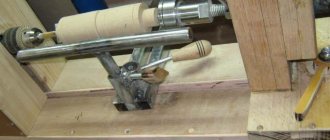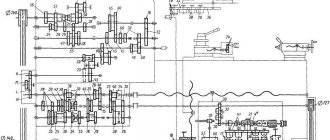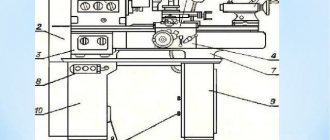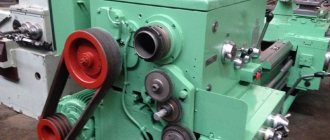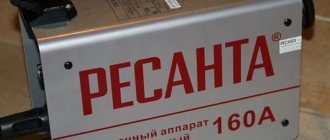Practical classes are the key to successful education of a specialist. You cannot become a real turner just by studying theory from textbooks. Here you must first learn how to operate the machine. For this purpose, back in the 80s of the last century, the production of the TV-6 screw-cutting lathe was started. It was produced at the Rostov teaching and machine equipment plant. This machine was made to teach the basics that every turner should know. This model could be found in many schools and special educational institutions.
Purpose
The TV-6 lathe was developed for teaching the basics of turning. Therefore, you don’t need to expect any sky-high characteristics from it. The machine is suitable for performing the most simple operations:
- Preparing holes.
- Trimming the ends.
- Cutting off part of the workpiece.
- Making metric threads.
- Boring of parts having a cylindrical (conical) shape.
The TV-6 lathe (“schoolboy,” as it is also called) can only work with non-ferrous metals and steel. This choice is explained by the fact that the material during processing should not emit volatile compounds and dust that have a detrimental effect on others.
Models and their differences, 9 photos
Despite the fact that they are used for training, they can also be used for processing elements that have a cylindrical and conical shape, cutting threads, grinding, knurling, sharpening tools, and so on.
Even if you want to do some work for which the machine is not suitable, the choice of additional devices to expand the capabilities of the device is huge. One of the most pleasant differences from conventional models is their compactness; they easily fit into the garage and do not take up much space. However, the functionality is almost the same.
Main characteristics
At first inspection, the TV-6 lathe surprises with its small size. Weighing 300 kilograms, its length is 144 centimeters, width – 47 cm, height – 110 cm. Thanks to this, the machine fits perfectly even into small workshops.
Small dimensions result in small parts that can be machined. The unit allows you to work with a part whose length does not exceed 35 cm. In this case, turning is possible at a distance whose length is no more than 30 cm. If we talk about height, then parts with a diameter of up to 20 cm can be processed above the bed. Above the support this value is only 8 centimeters.
The main characteristics in comparison with those of other units can be seen in the photo below.
Technical characteristics of training machines
The popular TV model - 4 has the following characteristics:
- Turning length - 300 mm.
- The spindle can rotate from 120 to 710 rpm, depending on the mode in which it operates.
- The rotation intensity of the product is adjustable at six speeds.
- The limit of longitudinal feeds varies between 0.08 to 0.12 mm/rev, while the pitch of the cut thread is from 0.8 mm to 1-1.25 mm.
- The diameter of the material that is installed above the bottom of the support and above the frame is 125 and 200 mm.
- The diameter of the hole in the spindle is 16 mm.
- The electric motor power is 0.6 kW.
These characteristics are quite sufficient for training or amateur work.
The device of the TV-6 lathe
Understanding what components and mechanisms the unit consists of will help you better understand the capabilities of the device. After all, it is the design that provides the specified technical characteristics.
The design is represented by the following main mechanisms:
- Cabinet (conditionally divided into two parts).
- Security screen.
- Transmission.
- Apron.
- Grandma (anterior and posterior are also conventionally distinguished).
- Bed.
- Guitar.
- Electrical engine.
- Trough.
A 6-speed gearbox is the front unit. A shaft is attached to it, which transmits rotation from the engine. A belt drive is used for this. The direction of movement of the cutter holder is changed due to a special mechanism installed in the box. This is adjusted using the handle. When it is turned, the gear moves to one of its extreme positions. If the gear rotates to the left, then a forward rotation process occurs. A block of gears is involved in this process. If the gear wheel moves to the right position, rotation occurs in the opposite direction. The rear assembly protects against radial runout. In addition, it allows you to machine holes using a drill.
Let us analyze the device of the TV-6 screw-cutting lathe in more detail. To do this, we will consider its main mechanisms and components (their operating principle and design) separately.
Vertical lathe 1512
On sale you can find a relatively small number of machines that can be used for processing large parts. Among all the models created at the time of the existence of the USSR, we note the 1512 rotary lathe. Its purpose is to process parts of medium and large sizes. Due to its high reliability and practicality in use, this model became the basis for the creation of various modifications and was actively imported to various countries around the world. The technical characteristics of the 1512 rotary lathe determine its applicability in mechanical engineering, shipbuilding or other production. When installing additional equipment, the purpose of the 1512 vertical turning lathe is significantly expanded; it can be used to carry out more than 10 types of processing of workpieces made of various alloys. The scope of application of the model 1512 is very extensive. As a rule, it is installed in the case of medium-scale and piece production of various parts. This is due to the fact that in the case of turning large workpieces, a large layer of material is removed. Even when using a cutting tool made of wear-resistant material, a layer can be removed in one pass, provided that the maximum force should not exceed 35 kN. The main operations that can be carried out on this equipment: Processing of conical and cylindrical surfaces. Performing boring operations. Passing a cutting tool along a flat surface, which is an end. Carrying out work on creating holes and boring them. The model has been produced since 1935 by the Krasnodar Sedina plant. After using this model for a long time, a fairly large number of different modifications appeared, which also became popular.
Cabinet
The design of the lathe divides the cabinet into two parts: front and back. They have a similar, but different structure.
The front cabinet is assembled in the shape of the letter “P”. To make the structure more durable, stiffening ribs are mounted at the bottom and top. The engine is located at the back of the cabinet. It turns on (off) by pressing a button located on the front of the cabinet.
The difference between the rear cabinet is that its design includes an electrical panel instead of a motor.
Screw-cutting lathe IT-1M
This unit is one of the most popular brands, which has found application in many workshops. Even educational institutions use the IT-1M lathe to develop the skills of their students. This model first appeared at the Ivanovo Machine Tool Plant, where employees were able to combine the best in one equipment: acceptable dimensions, high power, the ability to install additional components, etc.
It is important to note that this device belongs to the turning-screw-cutting group, but is lightweight. This feature makes it possible to operate the machine in mobile workshops, where technological operations of the following type are often carried out: processing of cylindrical blanks; axial drilling; carving; turning of conical blanks and much more. Nowadays, machine tools are also produced in Ivanovo, however, this model has already been discontinued
But many devices in excellent condition are sold on the secondary market.
Guitar and gearbox
A guitar is a gear transmission mechanism. It is necessary to transmit movement from the main shaft directly to the box. The guitar is a bracket with gears attached to it. The TV-6 lathe has a constant gear ratio, which is equal to one fourth.
The guitar transmits rotation to the gearbox. It, in turn, consists of the following parts:
- Shaft (2 pcs.).
- Gears (5 pieces with different characteristics).
- Clutch.
- Block gear.
- Drain plug.
- Running roller.
- Handle for settings (2 pcs.).
Thread parameters are determined by changing the settings of the handle, which is located on the front side of the gearbox. When it rotates (and it has 3 positions), the gear block, moving along the splines, engages another gear. On the panel of the box there is another handle that starts the drive shaft and screw.
Structural elements of equipment
The TV-6 model lathe consists of the following components:
- feed control box;
- front and rear cabinets;
- protective screen;
- trough for supplying lubricating oil;
- headstock;
- device apron;
- tailstock;
- supporting frame;
- electrical system elements;
- guitar;
- protective casing.
Main components and controls of the TV-6 machine
The feedbox of the TV-6 lathe, driven by a gearbox using transmission gears, consists of:
- two shafts;
- five gears with different parameters;
- block gears;
- running roller;
- couplings;
- round nut;
- shift handles;
- drain plug.
The handle on the front side of the feed box allows you to determine the parameters of the thread cut on the workpiece.
Another handle, located on the feed box panel, is responsible for turning on the machine’s running roller. The design of this unit of the TV-6 machine makes it impossible to simultaneously turn on the lead screw and the lead roller. Models of lathes belonging to the category of industrial equipment are also equipped with a similar safety system. Lubrication of all feed box components (gears and rubbing surfaces) is ensured by oil supplied from the trough using special wicks.
Headstock device
Tailstock device
The front cabinet has a U-shaped configuration, and to enhance its rigidity, there are special ribs in its upper and lower parts. On its back side there is a drive electric motor of the unit, and on the front side there is a button that controls its reversing switches. The rear TV-6 cabinet has a similar design; a panel with electrical equipment is mounted on it.
The tailstock, which has a mounting hole for Morse taper No. 2, includes the following elements:
- base;
- unit body;
- connecting screws;
- quill;
- key screw;
- flywheel to control the movement of the quill;
- handles for fixing the quill and the tailstock itself.
The tailstock design allows the quill to be moved up to 65 mm.
The frame of the device, due to which all its structural units are connected and supported in a given position, has a box-like structure with several windows. There are two prismatic guides on the frame, along one of which (front) the carriage moves, and along the second (rear) the tailstock of the unit moves. The load-bearing elements of the frame itself, in the front part of which a rail with a lead screw is attached, are two pedestals.
The most important mechanism of the TV-6 lathe is its apron, in which it is necessary to highlight the following elements:
- four gears (two worm and two rack and pinion);
- control handles;
- handwheel for manual feed control;
- queen nut;
- a running roller responsible for the longitudinal feed of the caliper;
- shaft.
Machine support
The support of the TV-6 screw-cutting lathe is composed of four carriages. This piece of equipment is responsible for fixing the cutting tool and moving it during metal processing. The tool holder, in which the working tool is fixed, is located on carriage No. 4; it is capable of moving along the guides of carriage No. 3 only in the longitudinal direction. The rotating carriage is No. 3, which is mounted on the second carriage. Carriage No. 2 is mounted on carriage No. 1, it is capable of moving along its guides in the transverse direction. Carriage No. 1 moves along the frame guides - in the longitudinal direction.
In order to transmit rotation from the gearbox of the unit to the elements of the feedbox, a transmission mechanism, also called a guitar, is used. The main structural element of the guitar is the bracket on which the gears are mounted. There are no replacement gears for the TV-6 machine, so the gear ratio provided by the guitar is constant and amounts to ¼.
TV-6 machine gearbox
Apron
An apron is necessary for feeding the caliper from the running roller (screw) mechanically or manually. If you need to feed manually, you should rotate the flywheel, which is located on the pinion shaft. The latter connects with the gear, which is located on the shaft of the rack and pinion gear.
A worm connected by a sliding key to a roller provides mechanical feed. It transmits the movement to the worm gear. From there, the movement is transmitted to the rack and pinion gear through the next gear and cam clutch. The jaw clutch is connected to a handle, the rotation of which leads to mechanical feed.
Safety rules when working on a lathe
The provisions of the safety rules are as follows:
- Compliance with the original technical specifications is mandatory when performing work. To do this, first obtain a drawing from the master. Or another type of description of the technological process associated with processing.
- Before starting work, be sure to conduct a technical inspection. This is necessary in order to detect and eliminate individual technical faults in a timely manner. If necessary, call a technician.
- Special clothes are fastened with all buttons.
https://youtube.com/watch?v=x1KTQFhY0YQ
Work cannot be started if any equipment adjustment or other types of maintenance are being carried out. Do not use machines whose centers are heavily worn. The same applies to any tools or clamping materials - you should discard them at the slightest sign of malfunction.
If the breakdown is related to the electrical part, the technicians are prohibited from fixing it themselves.
Caliper
The installation of cutters in the TV-6 metal lathe is carried out thanks to a support. Thanks to the presence of 4 slides (carriages), the cutters move:
- Along guides in the axial direction.
- In a direction perpendicular to the movement of the first carriage.
- In the axial direction along the guides of the third slide.
The carriages are installed in series, that is, on top of each other. The part is fixed to the fourth carriage using a special mechanism. When the handle is turned, the mechanism is pressed out and its position is secured with a pin.
Reviews
The TV-6 lathe is an excellent representative of the times of the Soviet Union. Made in the eighties of the last century, it is still found today. And many users are not going to give it up. This is a reliable, durable machine that performs its functions efficiently.
When deciding to purchase this model of lathe, experienced users are advised to answer two main questions:
- What accuracy is needed?
- What types of work are planned to be performed on the machine.
Of course, modern imported analogues outperform the TV-6 machine in terms of accuracy. But if you need to remove a thicker layer of metal, then you won’t find any equal to the “schoolboy”.
As for the second question, the machine is not capable of performing all the work. For example, as some users note, it was not possible to sharpen a pipe for cutters on the machine. To expand the functionality, you will need a set of replaceable gears, which are necessary for cutting threads using a cutter. They will allow you to change the step size if necessary.
One of the disadvantages is that the machine operates from an electrical network with a voltage of 380 V. If there is no power line at home, then the device must be converted to 220 V. Another disadvantage of this lathe is that it makes a very loud noise during operation. But on the other hand, if you install it in your private yard, then there will be no problems with this.
As you can see, the domestic TV-6 lathe for working with metal, which was produced for the purpose of teaching turning, has found its application in everyday life. It is used by many who like to make useful homemade products with their own hands. This is a reliable, durable unit, which even after almost four decades is in demand.
From soft to hard
Machines and equipment
We are on the territory of the Kolomna Heavy Machine Tool Plant, which turned 100 years old this year. In the Russian Empire, they started here with horse-drawn carts, then, in Soviet times, they made cannons and, finally, they moved on to machine tools. ZTS was a real giant of Soviet industry and occupied a vast territory, which is now divided between several legal entities. In general, what usually happened with this kind of enterprise in the years when the country was carried away by trade and finance happened: the plant went bankrupt. It turned out that Russian machines were not needed only by the Japanese. And yet, the centenary of the famous plant did not become a mourning date. Slowly, step by step, here in Kolomna, as well as in Sterlitamak, Ivanovo and other cities, the Russian machine tool industry is being born again.
And here's what's interesting. The people who stood at the origins of the new life of the famous Kolomna plant did not at all come from heavy industry. They came from the very “knowledge economy”. Back in 1995, a group of students, graduate students and graduates of the Moscow “Stankin” united into a production team and began to fulfill orders from Western machine tool companies to develop software for automated control systems. There was no talk of any “heavy metal” - it was an era when programmers and “computer scientists” in general were the heroes of the day. Gradually, the scope of activity and the circle of partners of the team - now it became known as ZAO Stankotech - expanded. There was an interest not only in creating software for machine tools, but also in their modernization and re-equipment based on modern CNC tools. Finally, in 2011, ZAO Stankotech came to Kolomna. The company absorbed the bankrupt enterprise SKB-ZTS LLC, created on the basis of the precision machine shop of the former Kolomna Heavy Engineering Plant. In these areas with a glorious history, the “machine technicians” began to create a new enterprise, which now not only modernizes old machines, but also produces new ones. In 2013, ZAO Stankotech, which manages production in Kolomna, merged with the machine tool plant in Sterlitamak (NPO Stankostroenie) into the STAN group. In October of this year, it was announced that two more machine-tool production facilities would join the group in Ryazan and Ivanovo.
Technologies Surgical operations “remotely”: is it possible?
Flexibility and precision In the photo, the pipe bending machine performs its slow but very delicate work. Under computer control, it creates complex three-dimensional configurations from pipes - such parts are used, in particular, in rocket fuel systems. Another new product of Stankotech JSC, located on the factory floor, is the OCP 300 model machining center, which is designed for processing large-sized parts (plates, frames, housings) made of light metal alloys and composite materials. The machine can process parts of any geometric shape from five sides without reinstallation.
The machines that are being built and will be built today in Kolomna are not ordinary equipment at all. A unique pipe bending machine has been manufactured and is operating in the workshop, a universal rolling mill URS-3200 is being gradually implemented in metal, and a machine for cutting out wafer backgrounds is being designed. No, confectionery products have nothing to do with it, and just listing the names of these machines is enough for an experienced person to understand which industry needed the latest Russian machines. But first, let’s talk about the Japanese.

